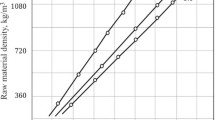Abstract
The method of experimental design is used to prepare vibration-cast mullite-corundum refractories based on corundum, fused mullite, and an alumina-containing material with a high thermal stability and strength and a low porosity. A charge is developed that provides articles with a heat resistance of 35 water heating cycles, an open porosity of 16.6%, and an ultimate compressive strength of 89 MPa.
Similar content being viewed by others
References
V. V. Primachenko, “Results of research — to industry,”Ogneupory, No. 11, 39 – 41 (1987).
Yu. P. Adler, E. V. Markova, and Yu. V. Granovskii,Design of Experiment in a Search for Optimum Conditions [in Russian], Nauka, Moscow (1971).
Yu. P. Adler,Introduction to Experimental Design [in Russian], Metallurgiya, Moscow (1969).
Author information
Authors and Affiliations
Additional information
Translated from Ogneupory, No. 10, pp. 11 – 13, October, 1995.
Rights and permissions
About this article
Cite this article
Primachenko, V.V., Kvasman, N.M. & Kolesnikov, L.M. Investigation of the dependence of the properties of vibration-cast refractory mullite-corundum articles on their composition by the method of experimental design. Refractories 36, 316–318 (1995). https://doi.org/10.1007/BF02227476
Received:
Issue Date:
DOI: https://doi.org/10.1007/BF02227476




